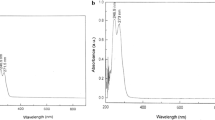Abstract
Removal of azo dyes from effluent generated by textile industries is rather difficult. Azo dyes represent a major class of synthetic colorants that are mutagenic and carcinogenic. Pseudomonas aeruginosa grew well in the presence of Remazol Orange (RO) and was able to decolorize and degrade it. In the present study, the decolorization and degradation efficiency using single culture P. aeruginosa with RO and textile wastewaters is studied. The elucidation of decolorization pathway for P. aeruginosa is of special interest. The degradation pathway and the metabolic products formed during the degradation were also predicted with the help of high performance liquid chromatography, Fourier transform infrared spectroscopy, and nuclear magnetic resonance spectroscopy analysis. The data show the cleavage of the azo dye RO to form both methyl metanilic acid and 4-aminobenzoic acid after decolorization and finally to oxidation forms benzoic acid, alkenes, aldehydes, and alkynes. The organism was able to decolorize the dye RO and wastewater effectively to the maximum of 82.4% and 62%, respectively.







Similar content being viewed by others
References
Bisschops, A. E., & Spanjers, H. (2003). Environmental Technology, 24, 1399–1411. doi:10.1080/09593330309385684.
Weisburger, J. H. (2002). Mutation Research, 506, 9–20.
Yeh, M. S., & Chang, J. S. (2004). Journal of Chemical Technology, 79, 1354–1360.
Nachiyar, C. V., & Rajakumar, G. S. (2005). Enzyme and Microbial Technology, 36, 503–509. doi:10.1016/j.enzmictec.2004.11.015.
Blumel, S., Knackmuss, H. J., & Stolz, A. (2002). Applied and Environmental Microbiology, 68, 3948–3955. doi:10.1128/AEM.68.8.3948-3955.2002.
Hu, T. L. (2001). Water Science and Technology, 43, 261–269.
Chang, J. S., & Lin, C. Y. (2001). Biotechnology Letters, 23, 631–636. doi:10.1023/A:1010306114286.
Ghosh, D. K., Mandal, A., & Chaudhuri, J. (1992). FEMS Microbiology Letters, 98, 229–234. doi:10.1111/j.1574-6968.1992.tb05519.x.
Wong, P. K., & Yuen, P. Y. (1996). Water Research, 30, 1736–1744. doi:10.1016/0043-1354(96) 00067-X.
Rafii, F., & Coleman, T. (1999). Journal of Basic Microbiology, 39, 29–35. doi:10.1002/(SICI) 1521-4028(199903) 39:1<29::AID-JOBM29>3.0.CO;2-W.
Sandhya, S., Padmavathy, S., Swaminathan, K., Subrahmanyam, Y. V., & Kaul, S. N. (2005). Process Biochemistry, 40, 885–890. doi:10.1016/j.procbio.2004.02.015.
Chang, J., Chou, C., Lin, P., Ho, J., & Hu, T. L. (2001). Water Research, 35, 2841–2850. doi:10.1016/S0043-1354(00) 00581-9.
APHA. (1998). Standard methods of water and wastewater (19th ed.). Washington D.C.: American Public Health Association.
Jeffery, G. A., Bassett, D., Mendhad, J., & Denney, R. C. (1991). Vogel’s text book of quantitative chemical analysis. New York: ELBS with Logman.
Chen, B. Y. (2002). Process Biochemistry, 38, 437–446. doi:10.1016/S0032-9592(02) 00151-6.
Shuler, M. L., & Kargi, F. (1992). Bioprocess Engineering Basic Concepts. New Jersey, USA: Prentice Hall.
Gumport, R. I., Jones, A., Mintel, R., Rhodes, C., & Koeppe, R. E. (1990). Student’s Comparison of Stryer’s Biochemistry. New York: W.H. Freeman.
Chen, B. Y., Chen, S. Y., Lin, M. Y., & Chang, J. S. (2006). Process Biochemistry, 38, 437–446. doi:10.1016/S0032-9592(02) 00151-6.
Hu, C., Yu, J. C., Hao, Z., & Wong, P. K. (2003). Applied Catalysis. B, Environmental, 42, 47–55. doi:10.1016/S0926-3373(02) 00214-X.
Bin, Y., Jiti, Z., Jing, W., Cuihong, D., Hongman, H., Zhiyong, S., et al. (2004). FEMS Microbiology Letters, 236, 129–136. doi:10.1111/j.1574-6968.2004.tb09638.x.
Nortemann, D. B., Baumyanten, J., Rast, H. G., & Knackmuss, H. J. (1986). Applied and Environmental Microbiology, 52, 1195–1202.
Supaka, N., Juntongjin, K., Damronglerd, S., Delia, M. L., & Strehaiano, P. (2004). Chemical Engineering Journal, 99, 169–176. doi:10.1016/j.cej.2003.09.010.
Acknowledgments
We thank the director of the National Environmental Engineering Research Institute, Nagpur, India for allowing us to publish this work. We are grateful to DBT, New Delhi for funding the project.
Author information
Authors and Affiliations
Corresponding author
Rights and permissions
About this article
Cite this article
Sarayu, K., Sandhya, S. Aerobic Biodegradation Pathway for Remazol Orange by Pseudomonas aeruginosa . Appl Biochem Biotechnol 160, 1241–1253 (2010). https://doi.org/10.1007/s12010-009-8592-1
Received:
Accepted:
Published:
Issue Date:
DOI: https://doi.org/10.1007/s12010-009-8592-1




